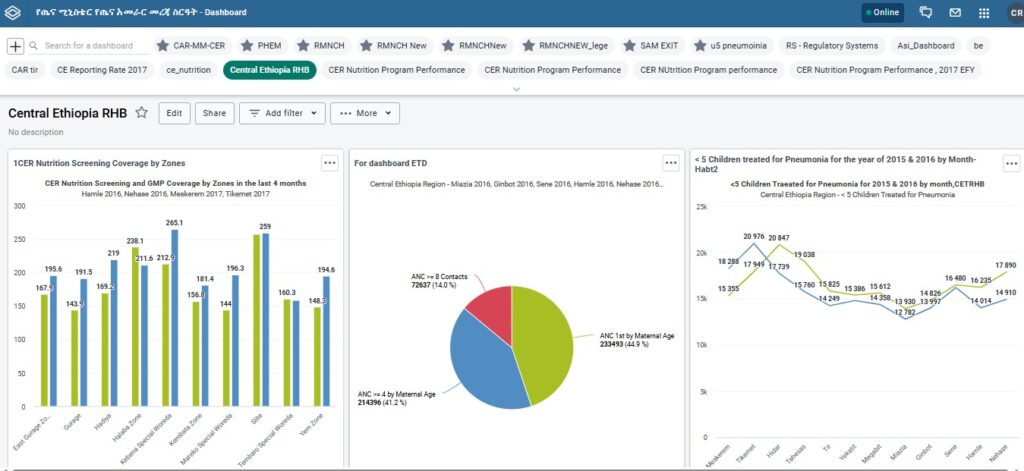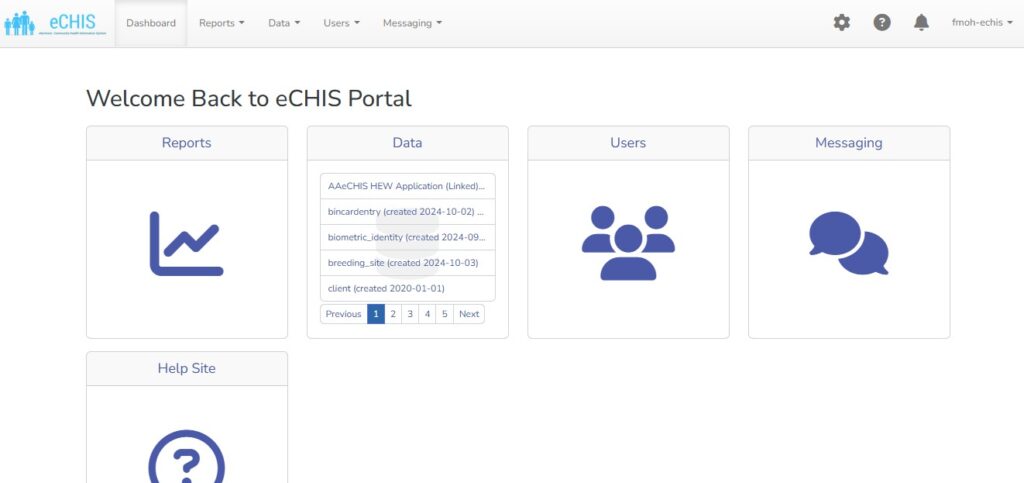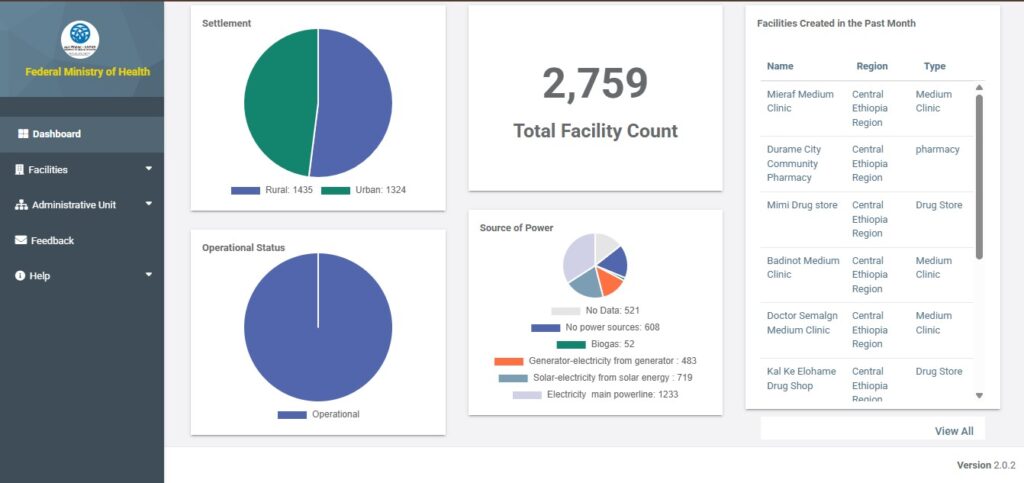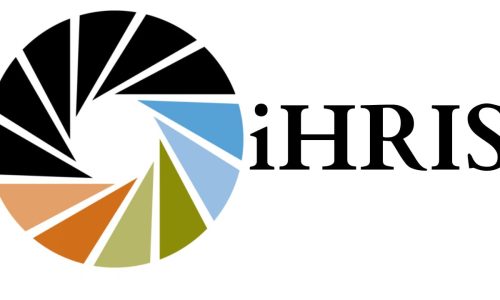Digital Health Systems
✅DHIS2
The DHIS2 is a powerful, open-source platform designed to improve the collection, management, and analysis of health data. It plays a pivotal role in strengthening health information systems at various levels of healthcare delivery. With the aim of enhancing decision-making, DHIS2 helps health organizations monitor and track key health indicators, ensuring that healthcare services are efficiently provided and resources are optimized.
In Ethiopia, DHIS2 has been implemented nationwide to help the Ministry of Health and regional health bureaus track the health status of populations, monitor health service delivery, and manage resources effectively. The system serves as a central hub for health data collection, analysis, and reporting at the regional health bureau and district levels, making it easier to monitor and respond to health trends in real-time. Read More DHIS2 is deployed across various health facilities, ranging from primary healthcare units to hospitals, where it collects data on essential services such as maternal and child health, immunization, disease outbreaks, nutrition, and more. The system facilitates better coordination across health sectors, enabling accurate reporting and timely interventions. DHIS2’s implementation has transformed the way Ethiopia manages and utilizes health data, creating a more responsive, efficient, and transparent healthcare system at all levels. This robust health information system is helping Ethiopia achieve its health goals and improving health outcomes for millions of people.✅ Key Features of DHIS2
🚀Key Features of DHIS2 Implementation
✅eCHIS
The electronic Community Health Information System (eCHIS) is a transformative digital health solution developed by the Ethiopian Ministry of Health to strengthen the country’s primary healthcare system. It digitizes the routine work of Health Extension Workers (HEWs), replacing traditional paper-based documentation with a smartphone or tablet-based application. eCHIS aims to improve data quality, enhance service delivery, and enable real-time decision-making at all levels of the health system.
Since its rollout, eCHIS has empowered HEWs to record household and individual health information more efficiently, track service delivery, and refer clients within the health system. The digital tool is integrated with the national Health Management Information System (HMIS) and contributes to better planning, monitoring, and response efforts across Ethiopia. Read More
✅ Key Features of eCHIS
- Mobile-Based Application: Enables HEWs to register households, record visits, provide services, and refer clients using smartphones or tablets.
- Integrated with DHIS2: Synchronizes community-level data with the national health information system for better data visibility and use.
- Improved Data Quality and Security: Reduces errors and ensures secure storage and transmission of health records.
- Real-Time Data Access: Supports timely decision-making through near real-time data synchronization.
- Offline Functionality: HEWs can continue working without internet and sync data once they regain connectivity.
- Supports Health Extension Program (HEP): Aligns with the Health Extension Program’s packages such as maternal health, child health, sanitation, and disease prevention.
📊 Benefits of eCHIS
- Increased efficiency and accuracy in community health data collection.
- Enhanced service delivery tracking and client follow-up.
- Strengthened referral systems between community and facility-level care.
- Enables better resource allocation and planning through improved data analytics.
The Master Facility Registry (MFR) is a cornerstone of Ethiopia’s digital health infrastructure, developed and led by the Federal Ministry of Health (FMoH) to support the harmonization and standardization of health facility information across the country. As a centralized and authoritative source, the MFR provides a comprehensive, up-to-date database of all public and private health facilities operating within Ethiopia’s health system.
The primary goal of the MFR is to ensure that all health systems, programs, and stakeholders are referencing the same consistent and verified list of facilities. This enhances data quality, interoperability, and coordination across various health information systems such as DHIS2, eCHIS, EMR systems, and logistics platforms. Each facility in the registry is assigned a unique identifier code, along with key metadata including facility name, location (region, zone, woreda), type, ownership, services provided, and operational status. Read More
By acting as a “single source of truth” for facility data, the MFR reduces duplication, improves service planning, and enables better integration of data across multiple platforms. It plays a vital role in supporting national health strategies such as the Health Sector Transformation Plan (HSTP) by enabling accurate facility-based reporting, resource allocation, and performance monitoring.
The MFR system is web-based and maintained through coordinated efforts between the Federal Ministry of Health, Regional Health Bureaus, and technical partners. It is regularly updated to reflect changes such as facility upgrades, closures, relocations, or reclassifications. Moreover, the MFR supports open data standards and can be integrated with global systems and health data repositories to strengthen health governance and accountability.
✅ Key Features of the MFR System
- Centralized Health Facility Database Maintains a comprehensive and standardized list of all public and private health facilities nationwide.
- Unique Facility Identification Assigns a unique ID to each health facility, ensuring consistency across health systems.
- Interoperability with Health Systems Seamlessly integrates with DHIS2, eCHIS, LMIS, EMR, and other national digital health platforms.
- Geographic Information System (GIS) Integration Includes geolocation data to support spatial mapping and planning.
- Real-Time Updates and Synchronization Allows continuous updating of facility information to reflect changes (e.g., upgrades, closures).
- Role-Based Access and Security Grants different access levels to ensure data integrity and secure management.
- Facility Classification and Metadata Stores detailed metadata such as facility type, ownership, services offered, and administrative hierarchy.
- Audit Trail and Change Logs Tracks changes made to facility data for accountability and transparency.
📊 Key Benefits of the MFR System
- Ensures Standardization Promotes consistency in facility names and codes across health systems and reports.
- Improves Data Quality and Accuracy Reduces duplication and errors in reporting by using a single source of truth.
- Enables System Interoperability Facilitates smooth data exchange between digital health platforms using standardized facility data.
- Supports Health Planning and Mapping Enhances resource allocation, coverage analysis, and gap identification through geospatial data.
- Optimizes Supply Chain Management Improves tracking and distribution of medical supplies and vaccines by knowing facility locations and services.
- Saves Time and Resources Minimizes manual verification and reconciliation of facility data during reporting or supervision.
- Strengthens Partner Coordination Allows implementing partners and donors to work from a harmonized facility list.
- Informs Strategic Decision-Making Provides accurate and up-to-date facility data for evidence-based policy development and program design.
- The Master Facility Registry is a critical enabler of Ethiopia’s digital health transformation, laying the foundation for a more efficient, transparent, and coordinated health system
✅EMR
The Electronic Medical Record (EMR) system in Ethiopia is a key digital health initiative developed to modernize and improve the management of patient records across healthcare facilities. Led by the Federal Ministry of Health (FMoH) in collaboration with regional health bureaus and development partners, the EMR system plays a crucial role in strengthening the country’s healthcare delivery through efficient, accurate, and accessible medical documentation.
EMR systems are implemented in health centers and hospitals to replace traditional paper-based patient records. These systems enable healthcare providers to electronically capture, store, and retrieve patient information, including clinical history, diagnoses, treatments, laboratory results, and medications. This digital transformation improves the continuity of care, reduces medical errors, and supports evidence-based clinical decisions at the point of service.
Ethiopia’s EMR systems are aligned with the national eHealth architecture and are designed to be interoperable with other digital health platforms such as DHIS2, eCHIS, and the Master Facility Registry (MFR). This interoperability ensures a seamless flow of health information between community, primary, and higher-level health institutions, promoting integrated patient care and better health system performance. Read More
Several EMR platforms have been piloted and scaled across Ethiopia, including SmartCare, OpenMRS, and regionally customized solutions. These systems are often configured based on facility needs and service readiness, with features that support outpatient and inpatient workflows, appointment scheduling, laboratory integration, and HIV/TB program tracking.
The successful implementation of EMR systems is supported by a strong governance framework, capacity-building initiatives, and regular technical assistance. Healthcare professionals receive training to ensure the proper use of the system, while ongoing supervision and infrastructure investments support sustainability and scalability.
✅ Key Features of EMR Systems
- Digital Patient Records Captures and stores patient history, diagnoses, treatments, and lab results electronically.
- Facility-Level Integration Connects services across departments such as outpatient, pharmacy, lab, and inpatient.
- Role-Based Access Control Ensures only authorized personnel can view or modify sensitive patient data.
- Synchronization with National Systems Interoperable with DHIS2, MFR, and other digital health platforms.
- Clinical Decision Support Provides alerts, reminders, and evidence-based guidelines during patient care.
- Appointment and Visit Tracking Tracks patient visits, scheduled appointments, and follow-ups efficiently.
- Integrated Lab and Pharmacy Modules Links lab requests/results and pharmacy dispensing to individual patient records.
- Online and Offline Functionality Works with or without internet access, syncing data when connectivity is available.
- Real-Time Data Entry Enables instant documentation at the point of care, reducing paper load.
📊 Key Benefits of EMR Systems
- Improved Quality of Care Accurate and timely patient data supports better diagnosis and treatment decisions.
- Time Efficiency Reduces time spent on manual documentation and searching paper records.
- Better Record Keeping Ensures complete and legible documentation of all patient interactions.
- Continuity of Care Enables seamless care across visits and departments through unified patient records.
- Reduced Medical Errors Minimizes risks related to misdiagnosis, drug interactions, and missed allergies.
- Enhanced Data for Planning Provides reliable patient-level data for health program planning and reporting.
- Environmentally Friendly Reduces dependency on paper, contributing to more sustainable operations.
- Empowered Health Workers Gives providers tools to make informed, timely, and evidence-based decisions.
The EMR system is a foundational pillar of Ethiopia’s digital health strategy, contributing to a more responsive, accountable, and data-driven health system that prioritizes patient care and service quality.
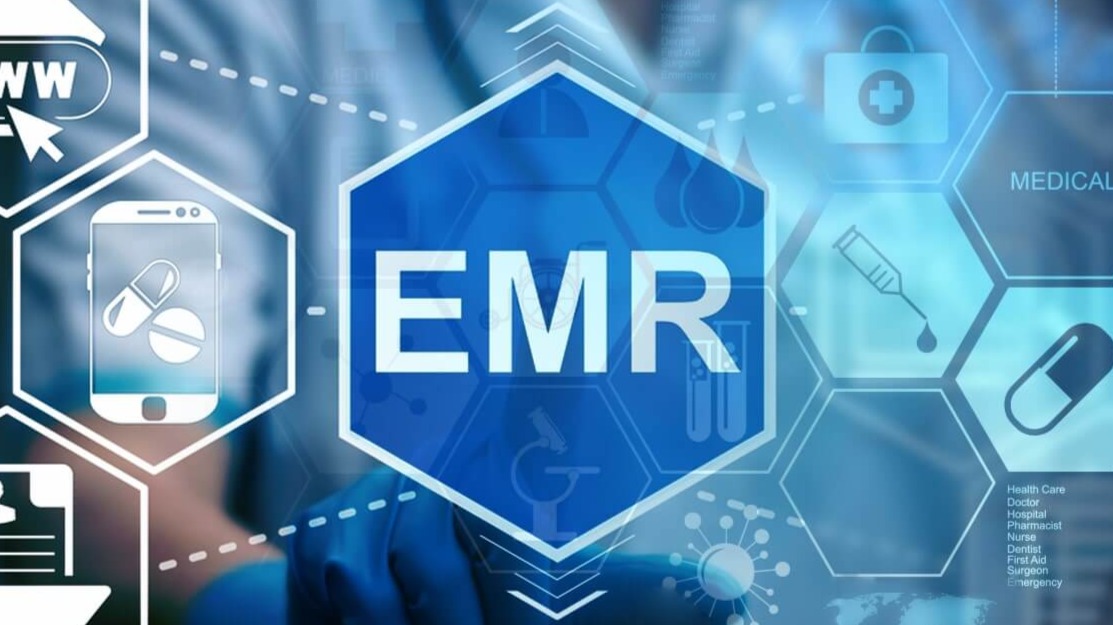
✅Dagu
Dagu is a compound software solution designed to manage supply chain functions at service delivery points. It includes an inventory management system at the facility store level and a patient service management system at the dispensing unit level. It is designed to manage daily transactions incorporating the business process and operations at each health facility.
IT is a logistic management information system (LMIS) software that automates inventory and transactional management throughout the supply chain. It supports interoperability through Application Programming Interfaces (APIs), enabling implementers to exchange data between Electronic Medical Record (EMR), Vitas, Fanos Dashboard, NSC dashboard, and other systems. The system facilitates the use of standard operating logistics procedures, including issuing and receiving items, employing the ‘first to expire, first out’ (FEFO) method, and tracking batch expiry. Additionally, Dagu assists in generating timely stock reports for decision-making and ensures the dispensing of the correct quantity and quality to the relevant clients with sufficient information for proper use. Moreover, Dagu improves management and access to logistic management information systems at the health facility level. It also facilitates information exchange with upstream supply chain units, enhancing coordination and efficiency across the entire supply chain. Read More
📊Benefits of Dagu
- Shortens requisition submission and fulfillment times
- Improves stock management (inventory levels between minimum and maximum)
- Swift transaction and ensure the provision of high-quality pharmacy service to patients
- Expands a visibility through timely reporting.
Dagu is a software application primarily developed for use in public health facilities, encompassing Government Hospitals, Health Centers, Refugee Health Centers, as well as private Hospitals and clinics. Its core functionalities include inventory management, acting as a transactional tool, aiding logistics decision-making, and serving as a tracking system within dispensary units to monitor the type, quantity, amount, and price of products consumed or scheduled for delivery to patients.
Dagu 2 is implemented within these facilities across various units, including stores, dispensing units (Electronic Auditable Pharmaceuticals Transactions and Service (eAPTS)), and PMIS (which targets individuals managing products crucial in combating epidemics such as HIV/AIDS). Additionally, Dagu 2 is customized for specific institutions like the Ethiopian Red Cross Society, PHEM-Ethiopian Public Health Institute, Dagu Warehouse (regional warehouse), and Dagu Mobile. Dagu is interoperability with other essential systems within the healthcare domain, including Electronic Medical Records (EMR), Vitas, the National Dashboard, and the upcoming EPSS system (ERP), ensuring seamless integration and efficient data exchange across platforms.
✅eMCS
In general terms, eMCS is an electronic catalog system that allows recording patients’ personal details and later retrieving them. And, it is designed to fulfill the need of automated medical catalog system that can reduce and if possible, avoid duplication of records, duplication of MRN, card loss and most importantly facilitate advanced record searching. Besides, the system allows generating reports, including but not limited to patient load, referral linkage and credit patient payment information, that are relevant for proper decision making by top level management.
eMCS is composed of a set of interrelated components organized together with the objective of efficient patient registration, advanced searching and generating reports. In doing so, the system will introduce efficiency and reduce the card room staff’s workload.
However, eMCS should not be confused with the Electronic Medical Record (EMR) system where by every details of diagnosis and medical records of patients are kept. Rather, this is a typical electronic catalog system. Read More
✅ Major parts of the eMCS
eMCS is a collection of interrelated components that are integrated for common purpose. The essential features that are incorporated in the system include but not limited to:
- Patient Registration module to capture patient’s personal details
- Advanced searching facility module
- Tracer card and appointment management module
- eMCS user management module
- Handling system settings including health facility setting, payment setting, referral linkage information setting, etc.
- Generating reports: referral report, patient load report, credit patient’s payment report, etc.
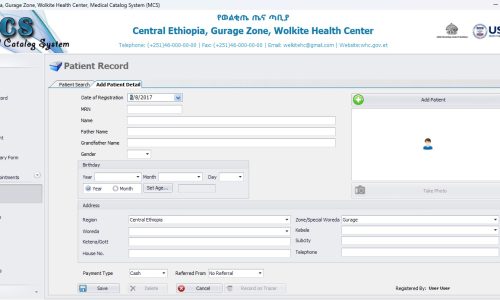
✅iHRIS
The Ministry of Health (MoH) introduced the second Health Sector Transformation Plan (HSTP2), which aims at improving the health status and well-being of the population through accelerating progress towards Universal Health Coverage, protecting people from health emergencies, contributing towards transformation of households and improving health system responsiveness. The MOH is digitizing health information systems that include the human resource information system as part of its reforms to get the necessary data for real time decision making. Human Resource Management (HRM) is a management function that helps managers to select, recruit, train, and develop employees for an organization, separation of human resources to the end that individual, organizational and societal objectives are accomplished.
The First National HRIS of Ethiopia was implemented in 2012 and was used to collect routinely the health work force data and Analysis. Read More
- However, it was not fully implemented throughout the country and some institutions data was not appropriately represented in it.
- iHRIS is an integrated Human resource Information system specifically designed for use in low-resource settings. It’s an open source Health Information System (HIS) that supplies health-sector leaders and experts with information to track, manage, and plan Human Resource for Health (HRH).
- Helps an organization manage its workforce more effectively and efficiently.
- A searchable database of all employees, their identifying information and their qualifications, and all HR management aspects.
- Helps decision-makers answer key human resource management and policy questions.
✅iHRIS Comprises of
- IHRIS-HRA: one module of the iHRIS that covers a wide range of HR functions including recruitment, personnel management, payroll, performance and leave.
- IHRIS-HRD: a module in iHRIS that enables to register CPD courses, accreditors, providers and pre service education
- HRIS-HRL: it’s one the suit of application in iHRIS that enable employees for applying a new license, renew and letter of good standing.


